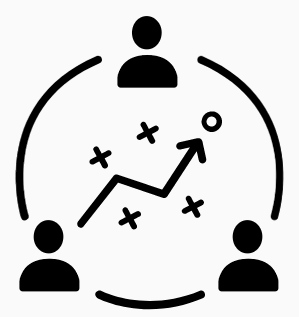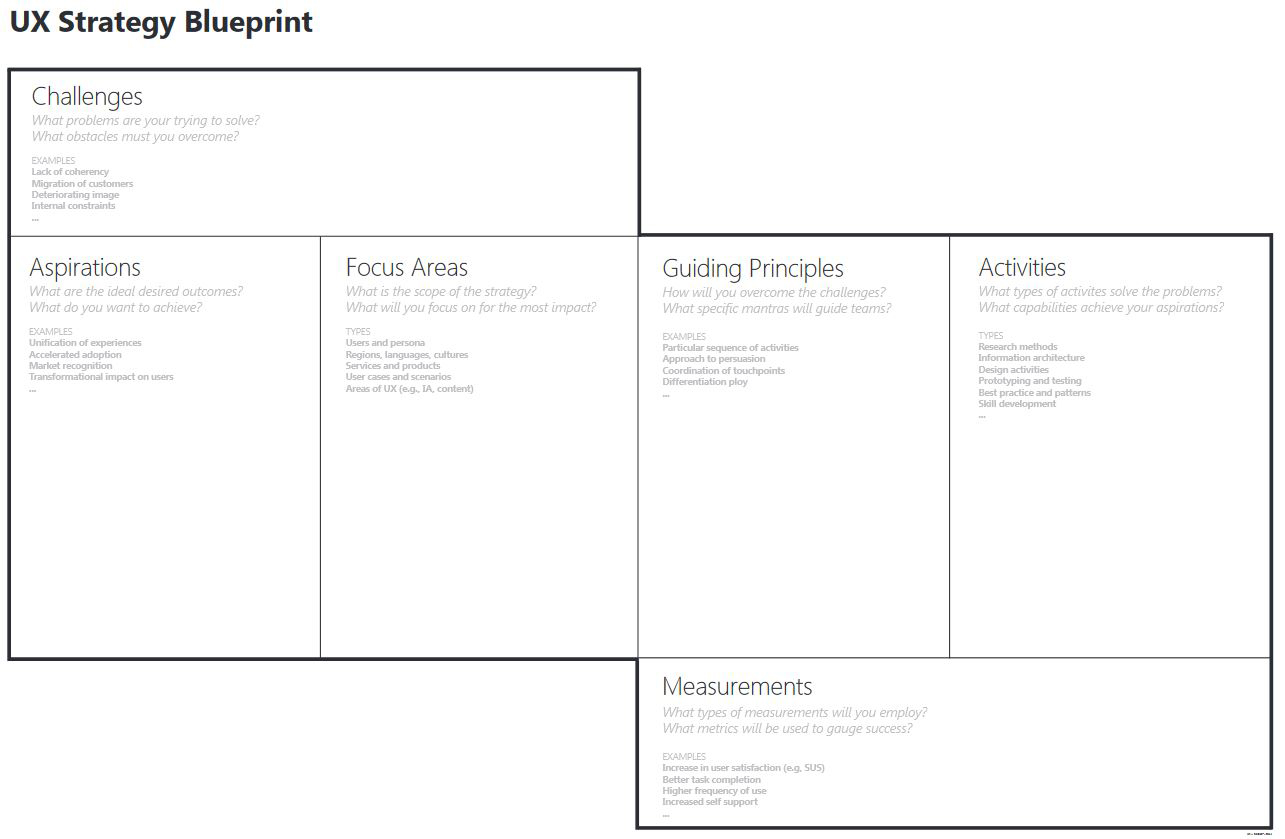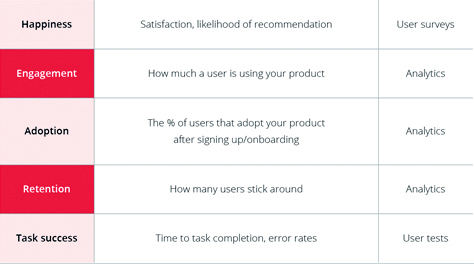
UX strategy
Enterprise UX strategy aims to improve the user experience for the actual user, who typically is not the buyer while aligning with business goals and IT constraints.
It is essential that an enterprise UX strategy encompass opportunities of all digital technologies—including Cloud, mobile, social, and analytics—because only through the holistic integration of these elements into a company’s business strategy can that company succeed in transforming their products’ user experience. UX professionals who are responsible for developing an enterprise UX strategy must take into account the needs of both the user and stakeholders in the C-suite, address the enterprise’s IT strategy and security issues, and aim for the best possible user experience within the inevitable constraints. Plus, at the end of a complex UX design process, product teams must produce applications that are easy to learn and use. As Don Norman has said, “What people care about is that they want to get their job done and feel happy when they’re finished.”
“UX strategy is about how design will help the business win in its strategy by providing value to customers in a uniquely meaningful way.”
Why you need a UX strategy
UX strategy means killer design strategy. By defining every aspect of the user experience before initiating the design phase, you’re giving your team direction for all aspects of the design. This means fewer misunderstandings, and less rework and resource wastage during the design process.
If that’s not enough of a reason to jump on the UX strategy bandwagon, here are some more incentives:
- To keep up with user behavioral patterns. As technology transforms and improves ever more rapidly, so does user behavior and adoption of new tools and features. Companies need to continue to predict user expectations and deliver digital products that delight users.
- To align different product teams around a shared product vision. This will help teams maintain consistency across UX touchpoints, features, and devices so that the user always has connected, frictionless experiences.
- To ensure that you have a plan to measure your successes and yes, your failures.
Developing an Enterprise UX Strategy
The development of an enterprise UX strategy occurs in phases, over an extended period of time.
Creating and implementing a UX strategy within a large enterprise is obviously not the work of a single day. The development of an enterprise UX strategy occurs in phases, over an extended period of time. The UX strategy is subject to ongoing review and validation. While the details of strategy creation vary from enterprise to enterprise, the process of devising an enterprise UX strategy generally comprises four phases:
-
Phase 1: Discovery and learning
-
Phase 2: Contextual research and planning
-
Phase 3: Strategy implementation and rollout
-
Phase 4: Validation and review
Phase 1: Discovery and Learning
To [create user-friendly software], you must base your UX strategy on user research rather than on stakeholder assumptions, consider … the enterprise’s strengths and weaknesses, and posit tactics a product team can employ.
The objective of an enterprise UX strategy is to provide a roadmap for creating digital outputs that are more user friendly. To achieve this goal, you must base your UX strategy on user research rather than on stakeholder assumptions, consider the context of the enterprise’s strengths and weaknesses, and posit tactics a product team can employ. The necessary research and data-driven learning take place during the first, or discovery, phase.
During discovery, consider the following questions: Who has requested a UX strategy and why? Was there a specific event that triggered demand for better a product user experience? Is productivity stagnant? Do training costs need to come down? Are customers abandoning your software at a certain point? Identifying the motivating factor behind the demand for better user experiences is the first step toward defining realistic success metrics—another aspect of a UX strategy.
Discovery is also the time to conduct user research, identify the painpoints of your current software, and find profit leaks. A full usability assessment of the enterprise’s existing software and digital platforms uncovers common problems, while an analytics assessment reveals UX issues.
Examining User Experience across the entire enterprise is essential. If no dedicated, in-house UX team currently exists, should the organization choose to outsource work or initiate a recruitment drive?
What changes will the enterprise need to introduce or scale up to get the job done? It may be necessary to invest in resources such as new hardware or additional manpower or adopt new work processes or relevant tools to realize UX improvements.
Phase 2: Contextual Research and Planning
Contextual research and planning enable enterprise teams to differentiate between successful and unsuccessful user experiences and accurately position their design decisions and value innovations within the competitive marketplace.
Things move very rapidly in the digital-product sector. So teams working on enterprise applications must be fully up to speed on digital-market shifts. Contextual research and planning enable enterprise teams to differentiate between successful and unsuccessful user experiences and accurately position their design decisions and value innovations within the competitive marketplace. For example, you should explicitly tie UX activities to go-to-market business objectives.
Integrating a user-research perspective into existing competitive analyses and conducting an unbiased appraisal of the external context for an enterprise’s market performance are necessary to generating a shared product vision.
Phase 3: Strategy Implementation and Rollout
Even the most complex enterprise can keep its UX strategy brief….
After research is complete, a UX strategy’s implementation phase begins. Even the most complex enterprise can keep its UX strategy brief—as short as two pages. While condensing all of the information you’ve gathered during the preceding two phases into a two-pager may sound challenging or even impossible, your UX strategy will be all the better for it.
Figure 1 shows an example of a concise, clean enterprise UX strategy template from..

Fig. 1
Phase 4: Validation and Review
An organization’s adoption of a user-centric mindset is an ongoing process, which will help embed User Experience in the organization’s culture.
Once you’ve created the UX strategy, make it visible by evangelizing it across the enterprise. An organization’s adoption of a user-centric mindset is an ongoing process, which will help embed User Experience in the organization’s culture. Optimizing a UX strategy requires continuous feedback and iterative improvement.
Validating a UX strategy across globally dispersed teams and multiple departments is no easy feat. However, consensus-building techniques such as affinity mapping, mediated facilitation, and conflict assessment can help enterprise UX professionals to understand the painpoints around the implementation of a UX strategy. Consciously carrying out these activities will help the UX team to prototype minimum viable products (MVPs)
Metrics
A UX strategy should make it clear what metrics relate to specific success indicators and how they tie back to particular activities.
Metrics are a key component of any UX strategy, and they’re one of the hardest things to get right. In an enterprise environment, conflicting stakeholder demands and highly complex systems further complicate the difficulty of collecting relevant metrics. Through a UX strategy, you can address potential confusion before it arises. A UX strategy should make it clear what metrics relate to specific success indicators and how they tie back to particular activities.
Relevant UX metrics you can adapt to an enterprise context by relating them to business goals. For example, a business that wants to cut internal training costs could measure the time to complete a task or the task success rate before and after a software update whose goal is to significantly improve these metrics.
Specific business goals can, and should, translate to specific metrics, just as design solutions should support particular business goals. More sample metrics: …
Tools for Developing an Enterprise UX Strategy
An enterprise UX team requires a broad range of skills in its toolkit—from user research and data analytics to wireframing and interaction design—to implement a contextually appropriate, business-friendly strategy. These skills include the following:
- stakeholder interviews—These are central to defining UX strategy because they give a much clearer understanding of stakeholders’ multiple, and often conflicting, needs. Employ Kim Goodwin’s stakeholder interview checklist.
- user personas—It is essential to base personas on data from user research rather than on stakeholder assumptions. Personas based on data will have greater acceptance.
- prototypes—Creating a prototype helps your team to refine its understanding of the requirements that a UX strategy defines and gives everyone the opportunity to provide feedback. Prototyping tools such as Justinmind help streamline the design-test-iterate workflow.
- interaction models—Diagrammatic or other representations of the interactive behavior of key user segments can reveal opportunities for digital improvements to established processes.
- user interviews—Whether you follow a descriptive, inferential, or evaluative approach, user interviews help you to appreciate the impact of an existing product user experience, enabling you to strategize a better product.
- sector-expert interviews—These are particularly useful if you’re designing software for an industry with which you’re unfamiliar. Seek out key subject-matter experts and influencers and learn from them.
- competitive analysis—The only way to devise a strategy that enables an enterprise to beat its competitors is to review and analyze competitive products—whether Web applications or sites or mobile apps. The resulting report will be foundational in defining the UX strategy.
- concept maps—Various types exist—for example, visual maps of users’ mental models of the processes they follow.
- HEART framework—This framework from Google is an outstanding tool for measuring and improving a released product’s user experience, as well as the success of a UX strategy against business metrics. The HEART acronym stands for Happiness, Engagement, Adoption, Retention, and Task Success. Figure 2 shows a simplified HEART framework. Google provides more in-depth information.

Fig. 2
Enterprise UX Strategy Do’s and Don’ts
You should abide by a few rules to ensure you create a UX strategy that works for users, stakeholders, and enterprise employees.
Each enterprise UX strategy has unique details, depending on the enterprise’s target users, business goals, and market environment. But you should abide by a few rules to ensure you create a UX strategy that works for users, stakeholders, and enterprise employees.
Do…
-
Create a conceptual guide, not a to-do list.
-
Build the strategy on the bedrock of data and learnings.
-
Include a competitive analysis to understand external threats and the business context.
-
Keep your strategy document short and concise.
-
Prototype and test, then revise your strategy as necessary.
Don’t…
-
Include unvalidated hypotheses based on sweeping assumptions
-
Expect the entire enterprise to adopt your strategy without a struggle.
-
Write up a list of application features.
Conclusion
The UX strategy reminds the team that what is good for the user is good for the enterprise.
While it may seem like a lengthy, in-depth process just to come away with a two-page strategy document, an enterprise UX strategy is the organization’s North Star and captures key user requirements. The UX strategy reminds the team that what is good for the user is good for the enterprise.
Creating and implementing a UX strategy inculcates good habits in an enterprise: the habits of design, user research, experimentation, and failing forward until systems become truly usable. By devising an evidence-based, cohesive UX strategy, an enterprise can succeed in the marketplace of the future. In contrast, enterprises that lack a UX strategy will fail in today’s new digital business reality
This article, which is based on the Justinmind ebook How to Make an Enterprise UX Friendly: A Quick Guide, considers the complexities of enterprise UX strategy, posits a general enterprise UX framework, and covers some tools and techniques that UX strategists employ, as well as do’s and don’ts for bringing UX strategy into a global enterprise.
